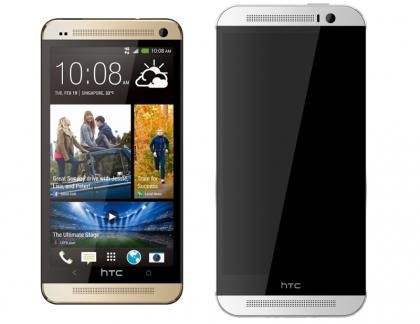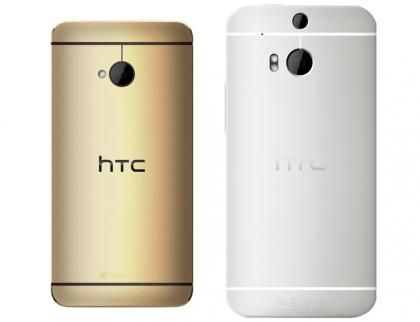HTC's new flagship smartphone is now official: the HTC One (m8) will be arriving in UK stores in the coming weeks, but how much of an upgrade is it over last year's model? We've put the 2014 edition side-by-side with the HTC One , comparing the two to highlight the differences and improvements HTC has made.
This is purely a specification comparison , highlighting the differences as they stand on paper. Where we've got benchmark figures, we've included them to highlight any differences in performance. However, until we get the HTC One (m8) in for a full review it's impossible to judge things like screen quality, battery life and camera image quality. We'll have to wait until April, when the phone officially goes on sale, to give a final verdict. In the meantime you can decide whether the 2014 edition will be worth waiting for, based on its specs.
SIZE AND WEIGHT
Materials : If there's one thing the HTC One received near universal acclaim for, it was design. Having been made almost entirely from metal, it eclipsed the likes of Samsung's plastic Galaxy S4 and rivalled Apple's iPhone 5 in terms of appearance and construction. It wasn't completely made from metal , however; HTC bonded the metal rear to the front display using a plastic frame . That has changed for the HTC One (m8), which is now entirely made from a metal alloy . Slightly rounded corners and a sculpted rear should mean the new handset fits more comfortably in the hand than the older, slightly boxier first generation phone.
The HTC One originally launched in a choice of black or silver metal finishes, with several other colour choices (red, gold and blue) added further down the line. The HTC One (m8) will initially launch with a choice of three colours: amber gold, arctic silver and Metal grey. The Metal Grey version has a 'hairline polish', a fine brushed metal finish, you can't feel it, but it glints in the light and clearly shows that the phone is made from metal.

The HTC One (m8) is larger than the old HTC One, but not significantly so
Dimensions : The HTC One measures 137x68x9.3mm and weighs 143g. It has a fairly angular design, with a slightly smoothed rear and rounded corners. The HTC One (m8) is larger and heavier overall, on account of the larger display (see below): it weighs in at 160g and has a 146x70x9.4mm footprint. For all intents and purposes, however, it will be very difficult to notice any difference when slipping the phone into your pocket should you be planning an upgrade.
SCREEN
Screen size : The HTC One has a 4.7in display , which is about as big as it's possible to get and still reach every part of the screen with one hand. The HTC One (m8) has a larger 5in display , which will prove a little trickier for small hands to reach the very top of the screen without using both hands. Both phones are protected from scratches and scrapes by Corning Gorilla Glass , although the older handset uses version 2 while the m8 has Gorilla Glass 3.
Resolution : Both the HTC One and HTC One (m8) have 1,920x1,080 Full HD resolution displays, but because the m8 has a slightly bigger screen, it has a lower pixel density. Whereas the HTC One has a pixel density of 469 pixels per inch (PPI) , the m8 only has 441ppi . In practice, the difference is unnoticeable, as both phones have pixel densities much higher than the point where it becomes possible to see individual pixels with the naked eye. Essentially, the HTC One had more pixels than was absolutely necessary, so the m8 could up the screen size without losing picture clarity.

The screen may be larger on the HTC One (m8), but it has the same resolution as the original HTC One
Screen technology : HTC has been using LCD displays for years, after early experiments with AMOLED panels gave way to SuperLCD screens. The difference between Super LCD and regular LCD is that the air gap between the display element and the outer glass has been removed. This should produce less glare and give the appearance of the display being closer to the surface. Power consumption and outdoor invisibility is also improved over regular LCD.
Both the HTC One and HTC One (m8) use SuperLCD 3 panels , which use a backlight to illuminate the screen. This means they produce brighter images and whiter whites than competing AMOLED screens. Conversely, AMOLED doesn't have a backlight, as each pixel illuminates individually. This saves battery life when displaying black pixels, and means blacks are much deeper than on an LCD screen, producing superior contrast. However, while Samsung's AMOLED phones use Pentile displays with diamond-arranged sub pixels; HTC uses three sub-pixels for every pixel, which makes everything sharper. Both technologies are now excellent, and on the best phones it's largely a matter of personal preference between the two.
PERFORMANCE
Processor : The HTC One made do with a quad-core Qualcomm Snapdragon 600 processor running at 1.7GHz, which was quick when the phone first launched but was soon eclipsed by the faster Snapdragon 800. HTC isn't making the same mistake twice, as the HTC One (m8) uses the latest and fastest Qualcomm processor: the Snapdragon 801 running at 2.3GHz . This will almost certainly translate to faster benchmark scores. The only test we've got top run so far is the SunSpider JavaScript test, which the m8 completed in just 640ms, a major improvement over the HTC One's 1073ms.
Graphics : The HTC One has a Qualcomm Adreno 320 GPU , which should play most of the games available on the Google Play Store with a smooth frame rate. It scores 6629 (26fps) overall in the 3DMark Ice Storm Extreme graphics benchmark, which was fast a year ago but is now beginning to show its age against newer smartphones. The HTC One (m8) has a faster Adreno 330 GPU, which should mean significantly higher frame rates even on brand new titles.
Memory : The HTC One was among the first set of Android smartphones to ship with 2GB of RAM . Larger phablet handsets now exceed this amount, but HTC has decided there's no reason to go higher for a mainstream smartphone: the HTC One (m8) will also ship with 2GB of RAM .
Storage : When it first launched, the HTC One was available with 32GB or 64GB of internal storage, but had no microSD card expansion for adding extra capacity later. The HTC One (m8) will launch in three storage options: 16GB , 32GB and 64GB , but also includes microSD (for the first time in an HTC flagship smartphone for several years). It supports the largest 128GB microSD cards, too, so you shouldn't ever have to worry about running out of storage space.
Battery : Battery life was arguably one of the HTC One's main weaknesses. It has a 2,300mAH battery, which we saw last eight hours and 30 minutes in a video rundown test. Playing games or using Wi-Fi, Bluetooth, 4G and NFC will also mean a reduced lifespan.
The HTC One (m8) has a larger 2,600mAH battery, but considering it has a slightly larger screen than the old model it's unknown whether it will last longer than the original HTC One. The company itself says the processor power management is significantly improved, and battery drain from the LCD panel has also been reduced, so it should last longer, but we won't know for sure until we get the handset in for a full review.
CAMERA
HTC introduced Ultrapixels to the world with the HTC One; the larger pixels mean less picture noise and a more accurate image when compared to a similarly sized sensor with more megapixels. The 4-Ultrapixel rear camera has a 1/3in sensor with 2µm pixels, significantly larger than most other smartphone cameras. It also has an f/2.0 aperture lens to capture as much light as possible per shot, along with optical image stabilisation to prevent camera shake. It is paired with an LED flash, which captures 2,688x1,520 stills and 1080p video at 30fps.

The dual-camera and True-Tone flash sets the HTC One (m8) apart from its predecessor
The HTC One (m8) might use the same 4-Ultrapixel sensor as the original One, but it pairs it with a second, depth-sensing camera to give owners control over the point of focus, even after they have pressed the shutter. Images are saved using a new version of HTC's image processing algorithm, paired with Qualcomm's on-chip imaging system. It also uses a dual LED True-Tone flash, which automatically matches the intensity and shade of the flash to match the scene being photographed. Otherwise it has the same 1/3in sensor , complete with oversized 2µm pixels , and f/2.0 aperture lens as the original One. It captures 2,592х1,944 stills and records 1080p video at 30fps.
The HTC One (m8) also has an improved front-facing camera; the 2.1-megapixel webcam found on the original HTC One has been replaced with a 5.0-megapixel camera paired with the same f/2.0 aperture lens as the rear-facing camera for improved low-light capture.
SOFTWARE
Android The HTC One first launched with the Android 4.1 Jelly Bean operating system, but has been upgraded to 4.3 and is due to receive an update to the latest 4.4 KitKat version in the coming weeks, if it hasn't already by the time you read this. The HTC One (m8) will arrive with the very latest 4.4.2 KitKat build, guaranteeing it is as up to date as possible when it launches.
Sense UI Although the changes are minor, the biggest visual differences between the HTC One and the new HTC One (m8) are in Sense , HTC's heavily customised Android skin. According to HTC, "every pixel has been touched" in an effort to streamline the skin, with new icons, larger images, a new colour scheme and customisable fonts.
The quick settings pull-down menu looks very similar to the default Android layout, albeit with a green tint, but the rest of the skin will feel very familiar to HTC owners. You can still hide apps in the App drawer and Blinkfeed is still just a swipe away from the home screen, but now stories are presented in a single flowing list, rather than by separate pages.

The HTC One (m8) is completely made from metal, unlike the old HTC One which has a plastic frame
4G and Wi-Fi
Both the HTC One and HTC One (m8) support all major 2G, 3G and 4G LTE frequency bands , although the m8 supports the faster LTE Category 4 while the HTC One makes do with the slower LTE Category 3 .
This difference aside, all other wireless technologies appear to be the same on both phones. They each support 802.11ac Wi-Fi , Bluetooth 4.0 , NFC , GPS and GLONASS geo-location, and an Infra-red blaster built into the top of the handset for controlling TVs or other home cinema equipment.
Internally, the m8 opts for the newer, smaller nano-SIM standard, as opposed to the original HTC One which uses the more familiar micro-SIM. Both use the same micro USB charging port.